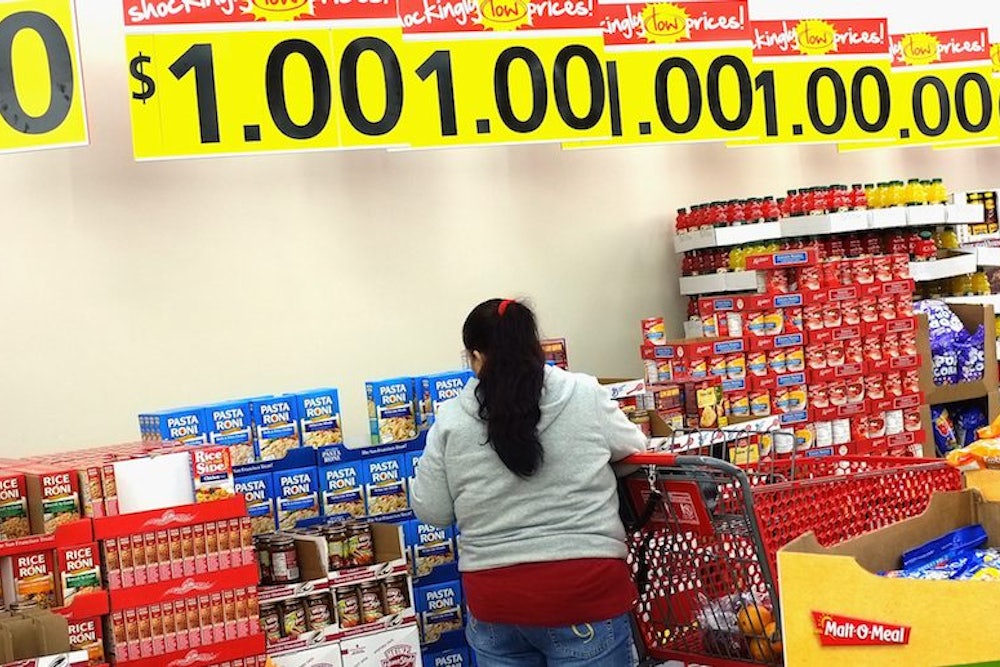National politicians have always been quick to rhapsodize about the middle class—what’s great about it, how to save it, the radical guy in the other party who threatens it. This is partly because the contours of such a social set are stubbornly, though usefully, indistinct. Well over half of Americans describe themselves as either “middle-class” or “upper-middle class” (just 2 percent consider themselves “upper class”), and politicians like to draw the boundaries as broadly as possible, the better to cater to potential voters.
The greater the middle-class monolith, however, the less attention is paid to its divisions and discontents. While it’s common to evoke the generational damage wreaked by the “middle-class squeeze” of rising income inequality, we direct focus away from the specific challenges faced by those barely keeping their heads above water, for whom the specter of deprivation lurks behind every missed paycheck or family illness.
The Brookings Institute’s Hamilton Project released a report Wednesday examining the travails of these Americans, a group it categorizes as the “struggling lower-middle class.” Subsisting on an annual household income of anywhere between $15,000 and $60,000 (100-250 percent of federal poverty standards, depending on size of household), these families have trouble making ends meet, depend heavily on government assistance, and yet still are counted among the country’s much-honored middle class. Here’s a brief look at some of the most disquieting claims advanced in the report.
Struggling families are everywhere
The struggle to stay out of the American underclass may be hidden in a society addicted to conspicuous consumption, but it exists in every community. According to the study, nearly one in three American working-age families with children qualify as struggling lower-middle class. Roughly one half of such families, therefore, are currently defined as poor or living in uncomfortable proximity to poverty.
Broken into income levels, this amounts to 54 percent of the nation’s families living on less than $60,000 per year and fully three quarters of them living on less than $100,000. While few liberals would classify this second sum as the earnings of a “struggling” family, it’s a telling benchmark for some of our policymakers: In last year’s presidential election, voters were presented with a choice between two candidates who claimed to believe that the middle class included any family making less than $200,000. In fact, those high earners represent less than 3 percent of all American families.
College won’t save you
Americans have long been promised that a college degree is their ticket to success and stability. That may be true—lucrative jobs are becoming harder and harder to find for those bearing only high school diplomas—but more of us are finding out that college alone can’t guarantee a firm footing in the middle class. Forty-eight percent of families designated as struggling lower-middle class are headed by a member who has attended college, including 14 percent who have attained a college degree or higher education level.
There isn’t enough good food
It is widely known that poor Americans are plagued with chronic health problems such as asthma, high blood pressure, and obesity to a far greater degree than their cohorts in higher income brackets, often due to the unavailability of healthy food. Tragically, nutritional deprivation affects huge swaths of the middle class as well. The U.S. Department of Agriculture classifies families as food insecure when they “[lack] access to enough food for an active, healthy life for all household members.” By this definition, about four in ten struggling lower middle class children experience food insecurity, obesity, or both.
The prevalence of the problem is striking and widespread: Roughly 22 percent of children nationwide suffer from food insecurity; in only two states (North Dakota and New Hampshire, both featuring small population and a low unemployment rate) are more than 85 percent of families food secure.
There is a lower-middle-class tax
Those in the struggling lower-middle class often face the highest marginal tax rates of any group. This is because they fall in an unwelcoming spot on the spectrum of American taxpayers: Those earning an income that exceeds the federal poverty line, but which thereby disqualifies them from receiving benefits like Medicaid, the Children’s Health Insurance Program, and the Earned Income Tax Credit. Since these programs are geared purposefully toward low-income families, the study suggests, the “unfortunate consequence is that some low-income households have little incentive to work because they risk losing significant benefits as they move up the income distribution.”
While living below the poverty line can kill you, getting above it will cost you.
